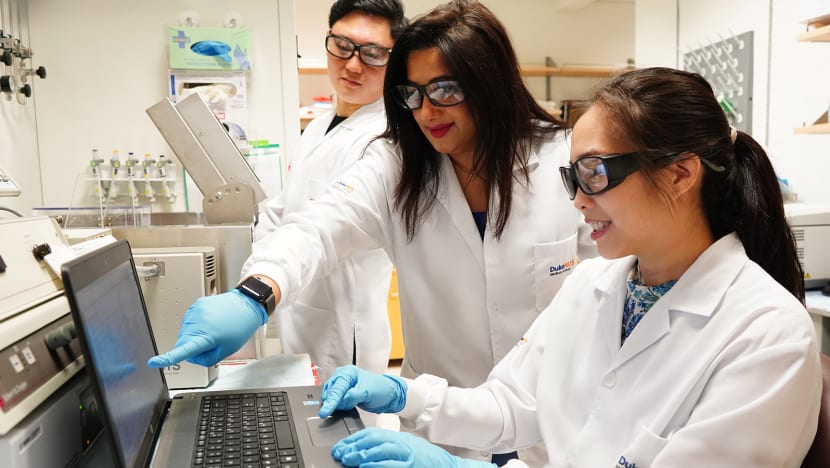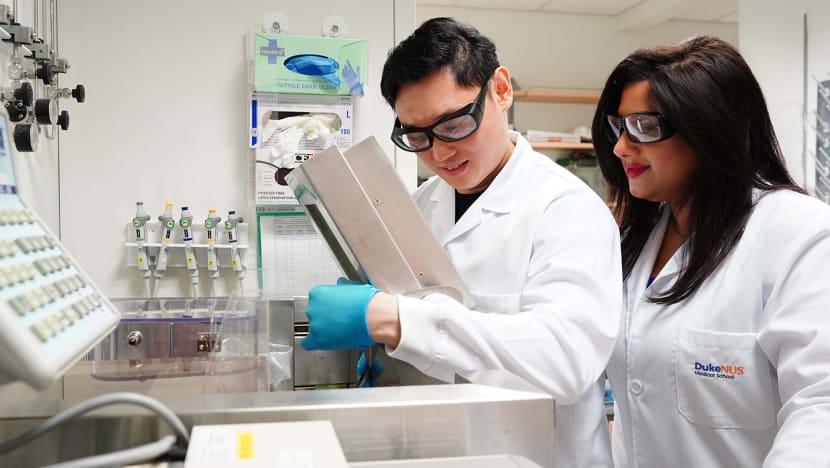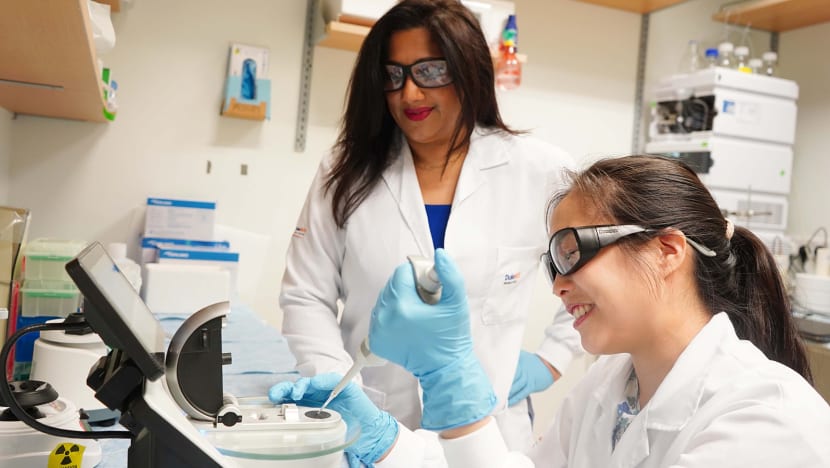Advancing medical frontiers by bridging the gap between the lab and the clinic
A multidisciplinary approach at Duke-NUS Medical School fosters collaboration between researchers and clinicians to enhance patient care.

From left: Dr Tan Kai Wei, Asst Prof Ann-Marie Chacko and Dr Sarah Tai are dedicated to addressing future clinical needs and creating impactful solutions for the world. Photos: Duke-NUS Medical School
Dr Sarah Tai found her calling in medicine because she wanted to comfort, heal and cure the sick. But after becoming a clinician, she could not shake off the feeling that more could be done to advance medical care.
“A senior clinician researcher once told me that he felt being a doctor was like a village experiencing floods, then rebuilding, only to be flooded again. Research, in contrast, is like building the dam,” she said.
Determined to contribute to these protective efforts in medicine, Dr Tai embarked on her PhD journey by enrolling in Duke-NUS Medical School’s Integrated Biology and Medicine programme. Her decision to pursue her doctoral studies at Duke-NUS’ Laboratory for Translational and Molecular Imaging (LTMI) was influenced by the institution’s strong focus on translational research and close affiliation with SingHealth institutes.
Concurrently serving as a clinician within the Singapore General Hospital’s Department of Nuclear Medicine and Molecular Imaging, Dr Tai’s research focus lies in designing radiolabelled molecules targeted toward disease signatures. This pursuit aims to address clinical needs that current non-invasive diagnostic and therapeutic tests fall short of fulfilling.
“Staying updated with my clinical work while pursuing my PhD is important as it enables me to hone my clinical skills and remain engaged in the clinical sphere, which presents the vital questions that drive meaningful translational research,” explained the Agency for Science, Technology and Research (A*STAR) scholar. “After all, if we want our research to ultimately benefit patients, its basis must come from addressing unmet clinical needs.”
A MULTIDISCIPLINARY AND PATIENT-CENTRED APPROACH
At LTMI, PhD students like Dr Tai work with researchers from a broad range of disciplines through partnerships with SingHealth institutes like the National Cancer Centre Singapore and Singapore General Hospital.
Part of Duke-NUS’ Cancer and Stem Cell Biology Signature Research Programme, the LTMI was founded in 2015 by Assistant Professor Ann-Marie Chacko to investigate the development of molecular imaging systems and how they can be applied to drug discovery and early drug development.
Then MD-PhD student Dr Tan Kai Wei, now a postdoctoral fellow, came across the LTMI at the end of his second year of medical school, when he was scrolling through the PhD faculty list at Duke-NUS as part of his search for a PhD project related to radiology.
“I was immediately drawn to the positron emission tomography (PET) images presented by Asst Prof Chacko,” he said. “While other imaging modalities such as computed tomography, X-ray, ultrasound and magnetic resonance imaging provide the anatomical information of organs, PET imaging adds value by providing another dimension of information, such as the expression of a certain antigen within cancer cells.”

By 2025, Dr Tan will complete his MD training and begin his time as a house officer. The opportunity to work with a variety of researchers at LTMI has given him a significant advantage as a clinician-scientist in training, he said.
“I have had the privilege of building a robust network across diverse disciplines encompassing research and medicine. This network includes professionals from fields such as physics, computational biology, organic chemistry, immunology, virology, cell biology, drug development, nuclear medicine and infectious diseases,” he noted. “Moreover, as we actively engage in patent filings, I am also gaining valuable insights from lawyers and patent officers.”
INNOVATING NOVEL SOLUTIONS, FOR MORE EFFECTIVE TREATMENT
Dr Tan’s research in the development of a PET imaging probe presents promising prospects for cancer diagnosis and treatment.
In the course of his PhD studies, he identified a lead molecule that could serve as a probe for the target programmed death-ligand 1 (PD-L1), which he describes as a ‘do-not-kill-me’ signal that is over expressed in cancer cells. This signal, when expressed in cancer cells, prevents immune cells from killing them.
While current drug treatment that targets PD-L1 can prevent immune cells from detecting the inhibitory signal and enable them to attack cancer cells, not all patients respond favourably. As some patients may exhibit a lower expression of PD-L1 – thus limiting the efficacy of the treatment – it is crucial to evaluate a patient’s expression of PD-L1.
Through non-invasive PET scans with the probe, doctors can assess PD-L1 expression within a patient’s tumours and metastases, and thus identify which patients will benefit from anti-PD-L1 therapeutics, said Dr Tan. This approach offers an effective, cost-efficient and low-risk means of determining appropriate treatment options.
Similarly, Dr Tai’s PhD research aims to provide information that will make a difference to patients’ treatment by enabling the greater customisation of treatment plans. It involves the development of a clinical trial for a peptide-based T-cell imaging probe, which is set to become Singapore’s first publicly funded radiolabelled diagnostic for clinical use and commercial licensing.
T cells are a type of immune cell that are actively involved in killing cancer cells. Dr Tai’s work is motivated by the need to more accurately identify patients who will respond positively to treatments that stimulate T cells. By assessing the “wakefulness” of T cells with the novel imaging probe, doctors can gauge the efficacy of new drugs in individual patients and tailor treatment plans accordingly.

Dr Tai is enthusiastic about the possibilities of such radiolabelled molecules, which she compares to “homing devices”. “As long as we have a target in mind, for example, a marker on a type of cancer cell, we can design drugs that bind specifically to it,” she explained. “By labelling these drugs with a radioactive component, we can use the radiation to either selectively detect – and therefore diagnose – or selectively kill, and therefore treat these diseases.”
She added that following her doctoral training, she hopes to collaborate with Asst Prof Chacko and fellow clinicians in developing a platform of new radiolabelled molecules, using the preclinical research skills and knowledge acquired at LTMI.
LEARNING TO MAKE AN IMPACT
Like Dr Tai and Dr Tan, the collective pursuit of making a difference in cancer has drawn many students from different disciplines to LTMI.
Working with the broader local and international community, the student researchers at LTMI aim to overcome challenges in medical technology development – such as cost, accessibility and adoption by doctors – by designing versatile solutions applicable to diverse hospital settings and diseases.
Asst Prof Chacko said that she founded LTMI with the hope that its multidisciplinary team would focus on creating impactful solutions for the world. She added that LTMI has brought together a wealth of clinical, translational, basic science and imaging research that not only complements the work done at the Cancer and Stem Cell Biology Signature Research Programme, but also benefits students by exposing them to cross-institutional knowledge, research and skills.
“This exposure empowers them to shape research questions more effectively and fosters a sense of optimism in their ability to make profound contributions in the future,” said Asst Prof Chacko. “Each student’s scientific learning journey is unique, so my advice is to stay curious and open to all possibilities as you create new knowledge through your research. And don’t hold back from continuously asking yourself and others: ‘Why?’”
Be on the cutting edge of science at Duke-NUS Medical School and learn more about its MD-PhD and PhD programmes.















